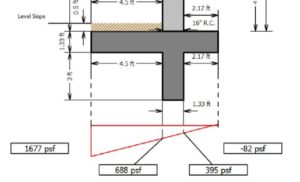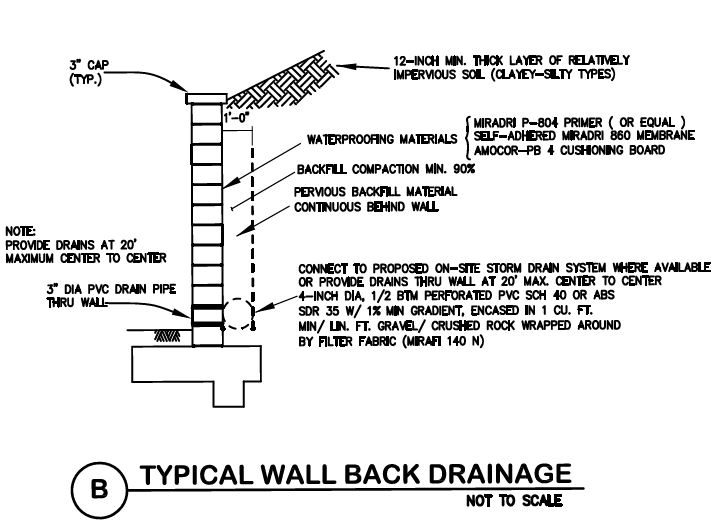123003 7 2003KeystoneRetainingWallSystems EquivalentFluidPressure Itiscommonforstructuralandgeotechnicalengineerstodefinetheactiveearthpressureloading. For an assumed earth pressure equivalent to that exerted by a fluid weighing not less than shown in Table No.

Geotechnical Engineering Retaining Wall Saturated Soil Hydrostatic Pressure Engineering Stack Exchange
To resist an equivalent fluid pressure of 78 pounds per cubic foot pcf.

. If the effective unit soil weight is multiplied by the lateral pressure coefficient K 0 which denotes at-rest K a or K p depending on whether the wall is moving and what direction it is moving it can be combined with the unit weight of water. At the wall face of stem design or measured at the heel of the footing for overturning and sliding. The more restrictive design shall govern.
Equivalent fluid pressure is a simplification of backfill earth pressure against retaining structures. 4-foot 12 m high gravity retaining wall equivalent fluid pressure of soil 30 pcf 47 kNm³ soil weight 100 pcf 157 kNm³ soil friction coefficient 055 soil bearing capacity 2000 lbft² 0096 MPa 100 solid concrete masonry units 120. Many design codes define minimum equivalent fluid pressures as a means for establishing a simple retaining wall design criteria without site.
Equivalent fluid pressure is a simplification of backfill earth pressure against retaining structures. Provide answer in ftkips to one decimal place. Use the soil classification chart above to identify the basic properties of the soil at the site.
For example a heavily battered retaining wall design 10 utilizing high assumed soil strengths ϕ 36 may result in very low calculated earth. If simple cantilever walls are being considered the passive resisting pressure on the level ground at the base of slope can be taken to be 280 pcf equivalent fluid pressure from ground surface to 5 feet and 350 psf equivalent fluid pressure at depths greater than. Water pressure can be greatly reduced by providing drainage aggregate and drain pipe directly behind the wall.
The benefit of equivalent fluid pressure analysis is that it typically creates a easily understood design loading regardless of structure geometry and soil design properties. Method involves the use of an equivalent fluid pressure which results in a simple triangular pressure distribution. As mentioned in my prior posting the only reason to use the term equivalent fluid pressure is that from measurements we have found that to a first order approximation the lateral earth pressures exerted on a retaining wall without a surcharge loading will increase linearly with depth in the same manner as would occur in a fluid and hence we can specify a.
For simple retaining wall structures in terms of equivalent fluid pressure such as 40 pcf for ease of calculation. If the backfill behind a cantilever retaining wall or restrained basement wall is level we can use the equivalent pressure. For a cantilever retaining wall level drained condition subdrain the equivalent fluid pressure is simply the product of Ka Gamma where Ka is the Active earth pressure coefficient Gamma is the moist unit weight of the backfill.
The wall could be a basement wall retaining wall earth support system such as sheet piling or soldier pile and lagging etc. 614 in Soil Pressure Toe 1809 psf OK Soil Pressure Heel 118 psf OK Allowable 2800 psf. For passive pressure 2200 in Equivalent Fluid Pressure Method.
Moreover the equivalent fluid refers to a hypothetical fluid having a unit weight that produces pressure against a lateral support of which its value is presumably equal to that the actual soil produces. 36 4000 lbft² 191520kPa. Given the retaining wall below and an equivalent fluid pressure of 35 pounder per cubic foot calculate.
32 3500 lbft² 167580kPa. Given the retaining wall below and an equivalent fluid pressure of 35 pounder per cubic foot calculate the overturning moment on the footing. Methods of determining surcharge loads on walls 3.
1 day agoCivil Engineering questions and answers. TABLE 1 Minimum Static Equivalent Fluid Pressures Surface Slope of Retained Material Horizontal H to Vertical V Equivalent Fluid Pressure 𝛾 𝑃 pounds per cubic foot pcf LEVEL 0 angle 30 5 to 1 32 4 to 1 35 3 to 1 38. Criteria for accepted engineering practice for design of retaining walls.
For a cantilever retaining wall level drained condition subdrain the equivalent fluid pressure is simply the product of Ka Gamma where Ka is the. Note that table of equivalent fluid weights for. USED for Overturning Resistance.
11 The objective of the study was to verify or modify existing lateral earth pressure design criteria through the use of long term field measurements of lateral earth pressures on full scale. We recommend a coefficient of friction of 038 and a passive pressure equal to an equivalent fluid weighing 280 pounds per cubic foot starting. Additionally the feature now allows the user to select a triangular or trapezoidal pressure distribution to model cantilevered retaining walls and restrained basement retaining walls for any height.
4-foot 12 m high gravity retaining wall equivalent fluid pressure of soil 30 pcf 47 kNm³ soil weight 100 pcf 157 kNm³ soil friction coefficient 055 soil bearing capacity 2000 lbft² 0096 MPa 100 solid concrete masonry units 120. Retaining wall design of equivalent height using only active pressure from Table of Equivalent Fluid Weights ForActive And At-Rest Pressure Based on Expansive SoilConditionsee above. In this course we will use the word wall to mean the vertical plane on which the earth pressure is acting.
These soil properties are approximate. Design fluid pressures for retaining walls supporting retained soil that is other than level backfill 2. Equivalent fluid pressure EFP is a simplification of the lateral loading that the soil exerts on an earth-retaining wall.
Wall Stability Ratios Overturning 232 OK Sliding 195 OK Total Bearing Load 3373 lbsresultant ecc. Together we have created a new support feature that allows the user to define a retaining wall using Equivalent Fluid Pressure EFP given in pounds per cubic foot pcf. Many design codes define minimum equivalent fluid pressures as a means for establishing a simple retaining wall design criteria without site specific analysis.
The following guidelines shall be used when designing a situational Case 2 retaining wall with seismic pressure. 27 2500 lbft² 119700kPa. The density of water is much less than most soils 64 pcf however its lateral pressure coeffcient is 10 so the Equivalent Fluid or Lateral pressure is 645 psfft which is higher than most soils in an active pressure case.
Experienced by the vertical wall on which the pressure is acting as shown in Figure 2 Page 4. If the backfill behind a cantilever retaining wall or restrained basement wall is level we can use the equivalent pressure.

Fhwa Center For Local Aid Support Publications

Equivalent Fluid Pressure Background Calculation And Design

Equivalent Fluid Pressure Background Calculation And Design

Ascending Backfill Equivalent Fluid Pressure In Retaining Walls Soilstructure Software

Cantilever And Restrained Retaining Wall Design Software Soilstructure Software


0 comments
Post a Comment